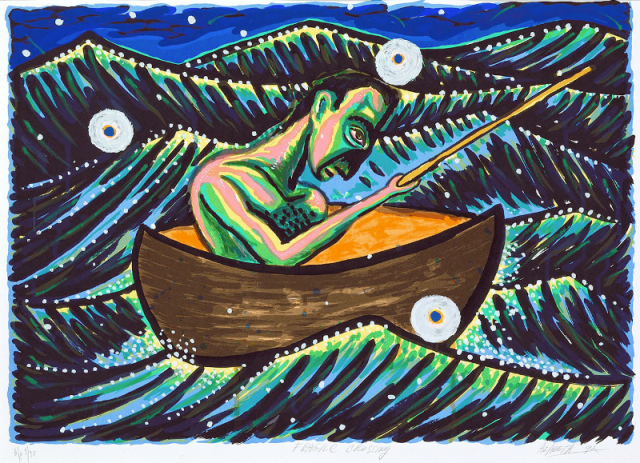Revisiting the "Balsero" Crisis and Its Aftermath, Twenty Years Later
| Start: | |
|---|---|
| End: | |
| Venue: | FIU Modesto A. Maidique Campus, Graham Center 150 |

Luis Cruz Azaceta, Fragile Crossing (1992)
On August 12, 1994, Fidel Castro announced that his government would let those Cubans who wanted to leave the island do so in any way they could. For the third time after Camarioca (1965) and Mariel (1980), the Castro regime encouraged a sudden and mass migration to the United States. Thousands of people took to the sea in small boats, homemade rafts, inner tubes, refurbished vehicles, and anything that floated. The ensuing balsero (rafter) crisis dramatized mounting social pressures due to worsening living conditions in Cuba during the so-called Special Period in Times of Peace.
Between August 13 and September 13, 1994, the U.S. Coast Guard detained 30,879 Cubans in the Florida Straits. This figure represented the largest number of Cuban immigrants in a single month since the Mariel boatlift. Signaling a major shift in U.S. policy toward Cuban immigration, the Coast Guard took the rafters to the U.S. naval base in Guantánamo, where they were detained until May 1995. The balsero crisis concluded when the U.S. and Cuban governments renewed their migration accords in September 1994 and May 1995. According to these agreements, all future rafters would be returned to Cuba and required to apply for a visa at the U.S. Interests Section in Havana.
The twentieth anniversary of the balsero crisis is a propitious occasion to reexamine several key issues raised by the contemporary Cuban diaspora. First, how have the rafters and other recent migrants from Cuba incorporated into U.S. and other societies? Second, how did the arrival of this new wave of migrants reconfigure the socioeconomic fabric of Cuban communities abroad? Third, how did the 1994 crisis change U.S. and Cuban policies toward the Cuban diaspora? Fourth, what are the alternatives to the "wet foot/dry foot" policy established by the Clinton administration at the height of the balsero crisis? Finally, what is the likelihood of another migration crisis, similar to the 1994 situation, given the lingering economic and political difficulties in Cuba?
In order to address these and other related questions, the Cuban Research Institute has invited a distinguished group of scholars, artists, and professionals who were directly involved with the balsero crisis. We will hear brief presentations from each participant, emphasizing their personal experiences and perspectives during and after the crisis. We hope our guests will help us understand the long-term consequences of the balsero crisis for the post-Soviet Cuban exodus as well as its impact in Miami, Florida, and beyond. In addition, we expect them to consider what can be done to prevent another chaotic episode in Cuban migration to the United States in the near future.
Confirmed Participants
- Dr. Holly Ackerman, Duke University Libraries
- Dr. Eugenio Rothe, Herbert Wertheim College of Medicine, FIU
- Mr. Siro del Castillo, Manuel Perea P.E. Consulting Engineers
- Mr. Willy Castellanos, Aluna Curatorial Collective
- Mr. José Basulto, Brothers to the Rescue
Cosponsored by the Frost Art Museum, this event is free and open to the public. The event is part of a series of exhibitions and programs across the city of Miami from August 14-October 31, coordinated by the Guantánamo Public Memory Project, which seeks to build public awareness of the long history of the U.S. naval station at Guantánamo, Bay, Cuba, and foster dialogue on the future of this place and the policies it shapes. Steered from Columbia University's Institute for the Study of Human Rights, the project is being developed by a growing collaboration of universities, organizations, and individuals.